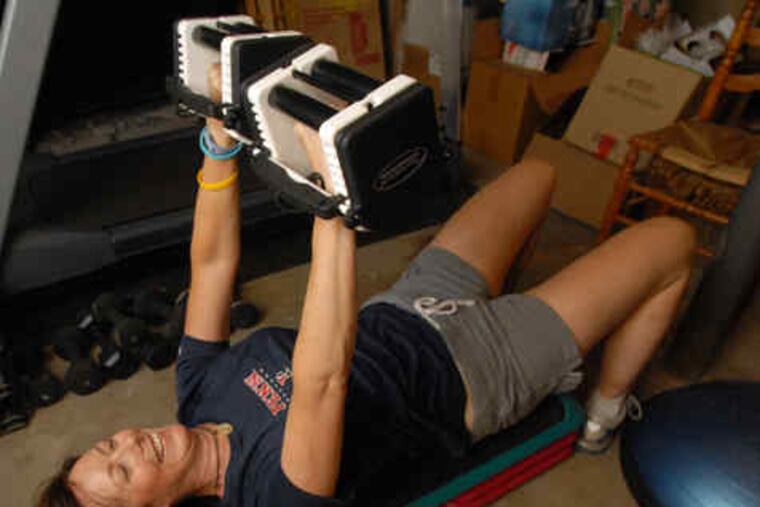Weightlifting professor attests to health benefits
Kathryn Schmitz's goal is to weigh at age 50 what she weighed at age 40. So she runs, bikes, does yoga and, importantly, lifts weights. She is 47 now, and just six pounds shy of her aim.

Kathryn Schmitz's goal is to weigh at age 50 what she weighed at age 40. So she runs, bikes, does yoga and, importantly, lifts weights. She is 47 now, and just six pounds shy of her aim.
At 5-foot-10, Schmitz, who lives in Merion with her two boys, carries those pounds invisibly, and it's easy to believe that for five years in her 20s, she was a dancer in New York, including a spell with the Martha Graham Dance Ensemble. For another five years, she was a personal trainer and manager of the Salomon Brothers executive fitness center in the erstwhile World Trade Center.
When clients began asking her questions she couldn't answer, she went back to school, earning a master's degree in exercise science from Queens College of the City University of New York. She later added a doctorate in exercise physiology and a master's in public health, both from the University of Minnesota.
Her broad and varied background has enriched her perspective. She considers herself "a crossbreed," combining exercise science and an interest in public health in a way that enables her to serve as a sort of personal trainer to the masses.
She does so from her perch at the University of Pennsylvania, where she is an associate professor in the department of biostatistics and epidemiology. Her recent work has focused on the effect of exercise on those recovering from disease, specifically breast cancer survivors.
The form of physical exertion that has attracted her interest, and increasing regard, is resistance exercise, or, weightlifting. To call it a panacea would be going too far, Schmitz says, but it is certainly an underrated palliative. "I call it the orphan exercise mode," she says.
In the so-called SHE study (for Strong, Healthy and Empowered), Schmitz and her co-researchers showed that resistance exercise significantly slowed middle-age weight gain, especially the accumulation of abdominal or visceral fat, which has been linked to such ills as diabetes, heart disease, and high blood pressure.
"The obesity epidemic is hard to reverse," Schmitz says. "Instead of trying to look like Halle Berry, let's reframe success as maintaining your current weight."
In the study, the abdominal fat of women who lifted weights twice a week increased 7 percent over two years. By contrast, the abdominal fat of women in the control group, who did no strength training, increased by 22 percent.
"You're not going to lose weight by lifting weights," Schmitz emphasizes, "but resistance exercise will help keep you from gaining more weight."
Weightlifting has this effect because muscle tissue is metabolically active. The more muscle you have, the more calories you burn, even at rest. Plus, the more muscle you have, Schmitz theorizes, the easier it is to be physically active. After months of lifting weights, women in the study could carry canoes farther than their husbands when portaging in Minnesota's lake country.
Resistance exercise is just as beneficial, it turns out, for the nation's 12 million cancer survivors. For years, the standard advice for cancer patients was to rest and avoid activity. Women recovering from breast cancer surgery were warned to lift no more than five pounds for fear it might precipitate or aggravate lymphedema, chronic swelling, usually of the arms or legs, caused by removal of the lymph nodes.
"Women absolutely fear it," Schmitz says. "Some say they'd rather have the other breast removed than get lymphedema. You can hide a mastectomy, but not a swollen arm."
Schmitz believed the guidelines were too risk-averse and impractical.
"My baby weighed eight pounds. A gallon of milk weighs eight pounds," she says. "When you consider what resistance exercise does for bone and metabolic health, it doesn't make sense. Exercise improves your body's ability to handle inflammation, injury, infection and trauma - the basic duties of the lymphatic system."
Which is exactly what Schmitz's PAL study (for Physical Activity and Lymphedema), published last year, showed. Not only was weight training safe, it mitigated the worsening of lymphedema by 50 percent.
That and similar findings spurred Schmitz and fellow members of an expert panel convened by the American College of Sports Medicine recently to declare: "Exercise training is safe during and after cancer treatments and results in improvements in physical functioning, quality of life, and cancer-related fatigue."
Addie Ford, 74, of Mount Airy, would agree. After a single mastectomy and the removal of 18 lymph nodes, Ford developed lymphedema. Recruited for the PAL study, she began a regular program of resistance exercise, which she continues today at a local rec center.
"Weightlifting has given me more control of my life," Ford says. "It keeps the fluids down and has given me more mobility and upper-body strength. Before, I could lift only one bag of groceries; now I can lift two. You have more freedom and can do your own thing."
Add Schmitz: "For so long, we've told people to walk or engage in aerobic exercise. If you do only one thing as an adult getting older, do resistance exercise. At the least, it will keep you strong enough that you're able to do aerobic exercise."